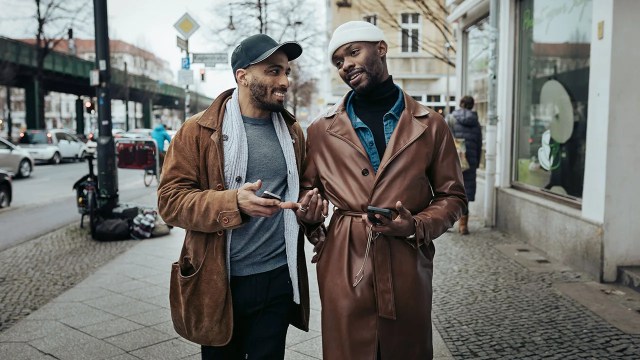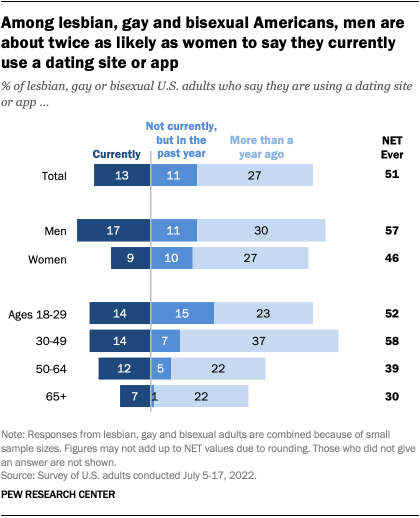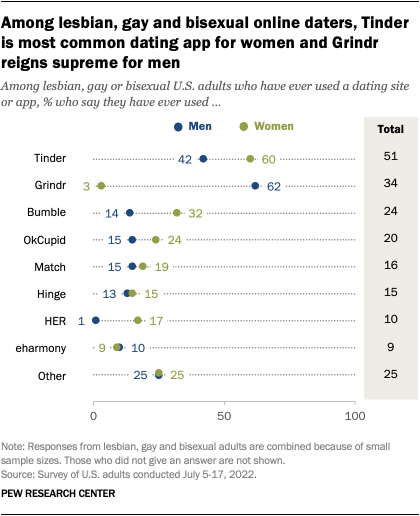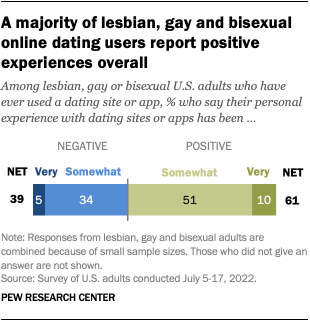About half of lesbian, gay and bisexual adults have used online dating

The internet has often provided a place for lesbian, gay and bisexual people to connect with one another when in-person venues are unavailable or unwelcoming. Lesbian, gay and bisexual Americans are far more likely than those who are straight to say they have ever used a dating site or app (51% vs. 28%), according to a 2022 Pew Research Center survey. That includes 13% of lesbian, gay and bisexual adults who say they are currently using an online dating platform, 11% who have used one in the past year and 27% who have done so more than a year ago at the time of the survey.
Responses for lesbian, gay and bisexual adults are combined because of small sample sizes. Additionally, since this research is focused on sexual orientation – not gender identity – and because the transgender population in the U.S. is very small, transgender respondents are not identified separately. Read the Center’s full online dating report for more details.
As Pride month ends, this analysis looks at how experiences with online dating differ by age and gender within the lesbian, gay and bisexual population.
Age and gender differences
Younger lesbian, gay and bisexual adults are more likely than their older counterparts to have tried online dating. Among lesbian, gay and bisexual adults, 54% of those ages 18 to 49 have ever used a dating site or app. That compares with 39% of those ages 50 to 64 and 30% of those 65 and older.
However, lesbian, gay and bisexual adults in the age groups under 65 are all equally as likely to say they are currently using a dating site or app. This is distinct from the pattern among straight adults, where those ages 18 to 29 are roughly three times as likely as those 30 to 49 or 50 to 64 to be currently using a dating site or app.

There are also differences by gender. Among lesbian, gay and bisexual adults, men are more likely than women to have ever used an online dating platform (57% vs. 46%) and to say they are current users (17% vs. 9%). These gender differences are also present among straight adults.
When it comes to finding a committed relationship, 24% of lesbian, gay and bisexual adults who are partnered – that is, married, living with a partner or in a committed romantic relationship – say they met their significant other through online dating. Among this group, men are more likely than women to say they met their significant other through a dating site or app (37% vs. 18%).
Most commonly used dating sites and apps

Lesbian, gay and bisexual men and women who date online also use specific apps and sites at different rates. Lesbian, gay and bisexual women users are more likely than their male counterparts to have ever used HER, a dating app for queer women and gender-diverse people. However, Tinder is the most common app among lesbian, gay and bisexual women users – six-in-ten say they’ve used it.
While Tinder is also popular among lesbian, gay and bisexual men, they are most likely to have used Grindr, a dating app for gay, bisexual, transgender and queer people. About six-in-ten lesbian, gay and bisexual men who have dated online (62%) say they have used Grindr.
About equal shares of lesbian, gay and bisexual men and women who have used an online dating platform have tried OkCupid, Match, Hinge or eharmony.
Online dating experiences and attitudes

In terms of personal experiences on online dating platforms, lesbian, gay and bisexual adults have mixed reviews. A majority of them who have used online dating platforms (61%) say their experience has been positive overall, with statistically similar shares of men (64%) and women (56%) saying this. But most lesbian, gay and bisexual adults who have used these platforms in the past year report feeling excited (85%) and report feeling disappointed (84%) about the people they encounter there.
Some lesbian, gay and bisexual online dating users also encounter negative behaviors. One-third or more say they have been sent sexually explicit messages they didn’t ask for (56%), had someone continue to contact them after they said they were not interested (42%) or had someone call them an offensive name (33%). Among lesbian, gay and bisexual users, the shares who say they have experienced each of these are not statistically different between men and women. Half of lesbian, gay and bisexual online dating users also say they’ve encountered someone they think was trying to scam them on these platforms, though this experience is significantly more common among lesbian, gay and bisexual men than women (60% vs. 41%).
Lesbian, gay and bisexual adults also have mixed feelings about online dating in general, outside of their own personal experience. They are more likely to say online dating has made finding a partner or spouse easier rather than harder (40% vs. 22%). Still, when asked what type of effect these sites have had on dating and relationships, roughly equal shares of lesbian, gay and bisexual adults say they have had a mostly positive (20%) or mostly negative (19%) effect.
Note: Here are the questions used for this analysis, along with responses, and its methodology.

No comments:
Post a Comment